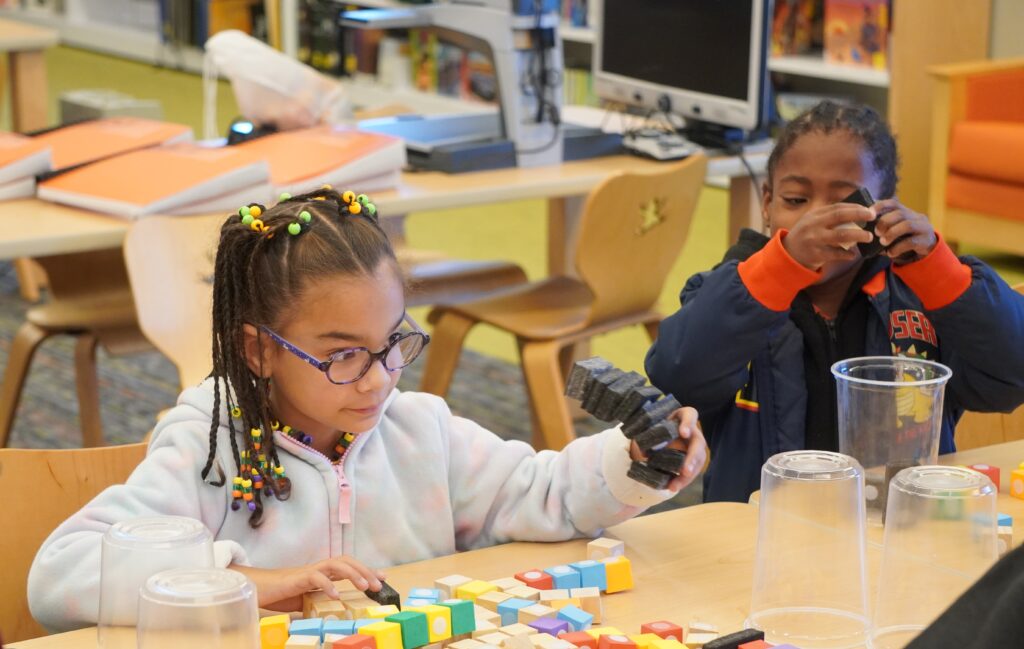Ava Williams, left, and Terrell Brown Jr., students at Maryland School for the Blind in Baltimore, participate in a STEM activity Friday using foam cubes and acoustic foam with Velcro, as part of Learning Undefeated activities. Photo by William J. Ford.
Dylan Burns’ task was to build a miniature chair from the building blocks in front of her. She rubbed a small wooden cube with Velcro attached to it, put it on the table and grabbed another item with Velcro, but this time it was a small piece of acoustic foam.
“This one feels different,” said Burns, 19, one of about a dozen students at the Maryland School for the Blind who spent part of Friday conducting STEM activities with instructors from Learning Undefeated.
The Gaithersburg-based nonprofit works to bring science, technology, engineering and math programming to underserved youth. While it’s been doing its work for more than 20 years, this week marked the first time it has brought its 1,000-square-foot Mobile eXploration Lab to the Maryland School for the Blind in Baltimore.
Janeé Pelletier, chief marketing officer with Learning Undefeated, said the Weinberg Foundation funded the visit not only to the School for the Blind, but also nine other schools in the city. The visits at each school began last school year.
“Our mission is to drive equity in STEM and a big part of what we talk to the students about and to our funders and partners is that having a diversity of people on your team makes you better at creating, at inventing,” Pelletier said. “We as a society need to build teams that have a diversity of perspectives. So, helping the students know there’s a place for them in STEM fields.”
Ashley LaVerdure, right, education program lead with Learning Undefeated, assists Nadia Gompers during a STEM activity Oct. 18 at Maryland School for the Blind in Baltimore. Photo by William J. Ford.
Friday marked the last day for Maryland School for the Blind students to participate in activities led by Learning Undefeated instructors, who combined STEM and storytelling using books such as “Goldilocks and the Three Bears,” “Jack and the Beanstalk” and “What If There Were No Bees?” The organization printed the books in Braille for students to read.
Because some students are in wheelchairs or have other mobility challenges, Friday’s projects were done in the school’s library and not in the organization’s mobile lab.
First, students listened to the stories and then instructors asked a few questions about a particular story. Then the students did the hands-on work of constructing items like a chair for Goldilocks to sit on, or designing an artificial pollinator that would seek to do the same job as bees.
Because the students are either blind, visually impaired or have low vision, some of the materials used to help in their projects included Velcro, colorful pompoms, foam and wooden cubes and construction paper.
But students weren’t bound by the construction materials: In addition to using the provided materials, three elementary-aged students used the cups the materials came in to build their Jack and the Beanstalk project.
“What are you making?” asked Emily Muhler, an education outreach coordinator with Learning Undefeated.
“I’m making a beanstalk,” replied Ava Williams, 7, a second-grade student.
“I wanna make a wall,” said Ava’s classmate, Terrell Brown Jr., 7, as he connected black acoustic foam pieces together.
Lucienne Penny works on her design of an artificial pollinator during a STEM activity Oct. 18 at Maryland School for the Blind in Baltimore. Photo by William J. Ford.
“You guys did great. You’re going to be future engineers,” Muhler said.
While Friday’s activities were designed to be fun, they also aimed to push for equity and inclusion in STEM-related fields.
Meanwhile, Lucienne Penny and Kindle Greene worked on a STEM project to collect pollen that included construction paper shaped as butterflies, Velcro, tape and pompoms. The original experiment uses baking soda, but the pompoms allowed the visually impaired students to count how much pollen they collected.
With the assistance of Muhler, Greene’s butterfly was nearly full of pollen, or pompoms. Greene will celebrate her 19th birthday Saturday.
Penny, also 19, didn’t collect as many pompoms.
“That’s all right,” she said. “I’m still OK.”

